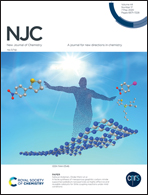A graphene–MnO2 composite supercapacitor material accomplished tactically using liquid–liquid and solid–liquid interface reaction techniques†
Abstract
A novel methodology is described to grow architectures of 3-dimensional graphene nanosheet (GNS)–manganese oxide (MnO2) composite materials to be used in supercapacitors. The in situ growth of the three-dimensional MnO2 fiber-network over the surface of graphene layers is achieved at the solid–liquid interface. The composite electrode shows good electron and charge transfer, rapid plus reversible faradaic reactions and excellent cyclic ability in electrochemical studies. The electrochemical properties of the as-prepared GNS–MnO2/FTO electrode material were assessed by cyclic voltammetry and galvanostatic charge/discharge tests. The specific capacitance of GNS–MnO2 reaches 683 F g−1 at a current density of 2.2 A g−1 and shows excellent cycle stability, retaining 96.9% of its initial capacitance up to 5000 cycles. A coulomb efficiency of about 99% displayed by the GNS–MnO2/FTO electrode is an excellent performance for a desired supercapacitor material. Herein, the charge storage mechanism in 3-dimensional graphene nanosheet (GNS)–manganese oxide (MnO2) composite is discussed in detail. Furthermore, at an elevated current density of ∼10.86 A g−1, a power density of ∼6.235 kW kg−1 is achieved, maintaining an energy density of ∼7.99 kW h kg−1; thus, it demonstrates promising potential as an electrode material for supercapacitor application.



 Please wait while we load your content...
Please wait while we load your content...